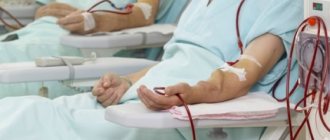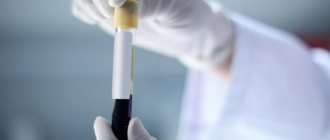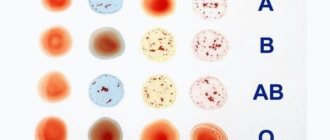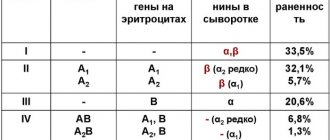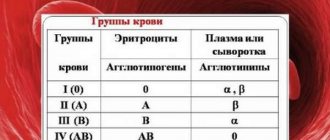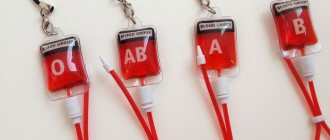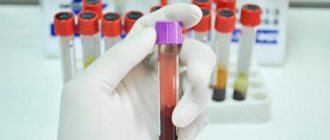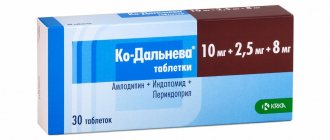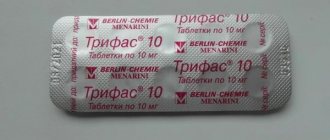Determination of blood group using zoliclones algorithm and interpretation of results
Determination of the group of erythrocyte antigens and the Rh factor has long become one of the mandatory studies for most patients admitted for hospital treatment. It can be carried out at any level of medical care, provided that the necessary reagents and instruments are available.
Typically, group determination is carried out using standard sera, although it is competed by another method, similar in methodology to the reference one - the use of zoliclones.
Tsoliclone is a monoclonal antibody produced by genetic engineering. Most often, mice are used to obtain it - a special antigen is injected into the animal, and then rodent ascites fluid is obtained, which contains the indicated antibodies.
Morphologically, they belong to class M immunoglobulins, i.e. acute phase antibodies. Their mechanism of action is due to the formation of an antigen-antibody complex, where some molecules (in this situation, proteins that determine the blood group and its Rh) located on the cell membrane act as antigens.
Credibility
The method for determining blood group and Rh factor using zoliclones is reliable and error-free. Therefore, you can absolutely trust him completely. It will accurately determine your blood type and Rh, which is why it is used in all countries.
Errors are possible only in cases where you performed the procedure incorrectly . It is possible that you violated the sequence of steps or added too many zoliclones, or perhaps, on the contrary, a small one. In any of these cases the procedure will be considered incorrect. You will see this when you begin to determine the results.
What types of tsoliclone preparations exist?
Currently, 3 types of standard zoliclones are used in laboratory diagnostics - anti-A, anti-B and anti-AB. Each of them reacts with an antigen specific to it, causing the development of an immune reaction.
These drugs are available in the form of ampoules or vials containing 5 or 10 ml of antibody solution. All of them have a specific color, which is used to determine each type:
- anti-A is colored red;
- anti-B is available in the form of a blue solution;
- the combined anti-AB (or anti-D) zolicone does not have a specific color.
Anti-AB zolicone can be modified and used to determine the Rh factor.
The research algorithm is quite simple; no special preparation for the study is required from the patient.
Determination of the group can be carried out in native blood either with or without the use of a preservative. For the study, capillary blood is taken from the patient’s finger.
It is imperative to observe environmental conditions to obtain reliable information: the analysis is carried out in a well-lit room with moderate humidity and a temperature of at least 20 degrees.
In addition, you should make sure that the blood was collected from the patient correctly and that the reagents used have not yet expired.
On a special plate (or tablet), at a distance from each other, using a special pipette, apply 1 large drop of each antibody (for convenience, it is better to place them like this - A, B, AB). It is necessary to place one drop of the test blood near each drop of the zoliclones and gradually mix them while rocking the tablet.
Visually, the results of the study can be determined within 5-10 seconds after the start of the analysis. In the blood tested, so-called “red conglomerates” are found - sticky red blood cells. They are formed as a result of an agglutination reaction, i.e. in the case when the tsoliklon corresponds to the antigen (including when testing for the Rh factor). If agglutination is not observed, then there is accordingly a discrepancy between the antigens being tested and the available antibodies.
How are research results assessed and group membership determined?
As mentioned above, the result of the study is determined by the presence of an agglutination reaction visually or using analyzers:
- if it is not in any of the drops, then the blood being tested is of the first group.
- when it is observed in the cell where the anti-A coliclone is located, it means that the blood being tested contains this antigen. Thus, the blood tested can be of the second (genotype AA or A0) or 4 (AB) groups.
- if agglutination is observed with anti-B coliclone, then the blood being tested is group 3 (BB, B0) or group 4.
To check the correctness of the results on the tablet, anti-AB zolicone is added (which also has the ability to determine the Rh factor). It is, to some extent, a control, since it is by the presence of agglutinates in it that the correctness of the analysis is judged. If the reaction occurs in all cells, then the sample being tested belongs to blood group 4.
It is possible that agglutination is observed with anti-AB coliclone, but is not observed in other samples. In this case, we can talk about an incorrect analysis, and the group and Rh factor are re-determined.
Method for determining blood group using standard sera
- Sign the plate (patient's full name);
- Label two series of standard sera of blood groups I, II and III in a volume of 0.1 ml, forming two rows of three drops from left to right: 0 (I), A (II), B (III);
- Take blood from a vein. Transfer six drops of the patient's blood to be tested with a glass rod onto the plate at six points next to a drop of standard serum and mix.
Agglutination will begin in 30 seconds. Add one drop of NaCl 0.9% to those drops where agglutination has occurred and evaluate the result.
Evaluation of results of determination of blood group using standard sera
A positive agglutination reaction may be sandy or petal-like. In case of a negative reaction, the drop remains uniformly colored red. The results of reactions in drops with sera of the same group (two series) must match. The belonging of the test blood to the corresponding group is determined by the presence or absence of agglutination when reacting with the corresponding sera after observation for 5 minutes. It should be noted that if the sera of all three groups gave a positive reaction, this indicates that the tested blood contains both agglutinogens (A and B) and belongs to group AB (IV). However, in such cases, to exclude a nonspecific agglutination reaction, it is necessary to conduct an additional control study of the test blood with standard isohemagglutinating serum of group AB (IV), which does not contain agglutinins. Only the absence of agglutination in this drop in the presence of agglutination in drops containing standard sera of groups 0 (I), A (II) and B (III) allows us to consider the reaction specific and classify the test blood as group AB (IV).
Method for determining blood group by cross method
What to consider when conducting analysis
In order for the analysis result to be as reliable as possible, a number of conditions must be met during the procedure:
- reagents should be stored in a cool place at a temperature of +2-8 degrees in bottles with a tightly screwed cap (if storage rules are violated, they quickly lose their properties);
- For analysis, you cannot use cyclones that have expired (about 30 days) or liquids that contain sediment, flakes or debris;
- the study is performed in a well-lit room at an air temperature of no lower than +15 and no higher than +25 degrees, and there should be no dirt, dust or other factors that can distort the result;
- when applying biomaterial and reagents to the surface of the tablet, the proportions must be strictly observed - if there is too much blood, the reaction is more difficult to track, and in the opposite case (with a small volume) it will be too slow;
- Drops of blood mixed with different types of zoliclones should not be allowed to merge together - if this happens, the test is carried out again; for the same reason, different sticks should be used to mix reagents with biomaterial.
The reaction duration should be at least 3 minutes, and if the result is questionable, the observation time for biomaterial samples should be extended to 5 minutes. However, after 10 minutes, the biomaterial may dry out and red blood cells may naturally precipitate, so you should not trust such a study.
How is the research conducted?
To determine a blood group using cyclones, you need a flat, even surface (plate) moistened with water, a set of chemical reagents and biological fluid samples, and a specialist can use any blood: capillary, venous, frozen, etc.
- The sides of the tablet are marked so as not to confuse which of them will be applied to one or another type of zoliclones.
Procedure for determining blood group using zoliclones
- One drop of reagents (usually anti-A and anti-B cyclones) and blood are dropped onto the surface, and the volume of chemicals should be 8-10 times greater than the volume of the biomaterial.
- Wait 3-5 minutes, gently rocking the plate so that the liquids are well mixed and red blood cells do not settle around the edges of the samples.
Tablet for determining blood group
Important! After a few minutes, a reaction will occur, by which it is possible to determine with high accuracy whether the blood belongs to a certain group.
Reaction with standard red blood cells
To react with standard red blood cells, standard red blood cells of three blood groups are required: 0 (I), A (II), B (III).
Method of performing the reaction with standard red blood cells
- Blood for research is taken from a vein into a test tube, centrifuged or left for 30 minutes to obtain serum.
- Three large drops (0.1 ml) of blood serum from a test tube are applied to a marked plate, and next to them one small drop (0.01 ml) of standard red blood cells of the groups.
- The corresponding drops are mixed with glass rods, the tablet is shaken, observed for 5 minutes, NaCl 0.9% is added to the agglutination drops and the result is assessed.
Evaluation of the results of the reaction with standard erythrocytes
The results obtained with standard isohemagglutinating sera and standard erythrocytes are evaluated. A peculiarity of the results of the reaction with standard erythrocytes is that erythrocytes of group 0 (I) are considered control. The result of the crossover method is considered reliable if, when reacting with standard isohemagglutinating sera and with standard erythrocytes, the answers about the blood group being tested coincide. If this does not happen, both reactions should be redone.
Decoding
To determine the blood group using cyclones based on the results of chemical reactions, you can use a specially designed table.
| Blood type | Reaction with anti-A | Reaction with anti-B | Reaction with anti-AV |
| I (0) | — | — | — |
| II (A) | + | — | + |
| III (B) | — | + | + |
| IV (AB) | + | + | + |
Decoding the results
A few minutes after combining the reagents, the results can be observed. Complete mixing of liquids indicates the absence of a reaction, and agglutination is manifested by the appearance of red clots in a clear solution. These are red blood cells that stick together when in contact with incompatible monoclonal antibodies. Next, you can decipher the results using a simple algorithm:
We also recommend reading: What is blood type and Rh factor (table)
- Group 1 (0) - agglutination is absent in both drops, since there are no agglutinogens on the red blood cells;
- Group 2 (A) - the reaction is observed in the first drop with anti-A tsoliclone;
- Group 3 (B) - in the second drop, red blood cells stick together upon contact with the anti-B reagent;
- Group 4 (AB) - the appearance of a red precipitate in both drops.
The fourth blood group is considered the rarest, therefore, if agglutination appears in both wells, the analysis is repeated. In addition, blood must be added to normal saline solution to eliminate the possibility of dangerous diseases. In a healthy person, it will not react in any way with saline, and the red blood cells will not stick together.
What are zoliclones?
Zolicons are monoclonal antibodies that are found in saline solution. The substance received its name in honor of its inventors - the Central Order of Lenin Institute, today renamed the Hematological Research Center. They are presented as a liquid, which is sold in bottles of 5 and 10 ml. This is a universal reagent for hematological studies, since it allows you to determine the blood group in both the AB0 and Rh systems.
There are 3 main types of zoliclones:
- anti-A - red liquid;
- anti-B - blue substance;
- anti-D is a transparent reagent for determining the Rh factor.
Anti-A and anti-B zoliclones are used to determine blood group. They enter into biochemical reactions with agglutinogens, which are located on the surface of erythrocytes - red blood cells. Blood group A red blood cells contain agglutinogen A, which will react with anti-A zoliclone. The content of agglutingen B is determined in the same way. The gluing of red blood cells and their precipitation is considered a positive result of the reaction.
REFERENCE! Agglutination is the gluing of substances. Agglutinogens are compounds that are found on the surface of red blood cells and cause them to stick together when incompatible blood groups are combined.
Why is the analysis carried out?
Group and Rh factor are genetically determined blood characteristics that are inherited from parents and remain unchanged throughout a person’s life. The classification of blood groups is carried out based on a certain set of biochemical parameters and the composition of antigens, and has 4 main groups. Transfusing a patient with blood of an incompatible group or with a different Rh factor carries with it a mortal danger - the immune system begins to produce antibodies against foreign cells that attack and destroy them. It is for this reason that in situations that carry the risk of extensive blood loss, it is necessary to accurately determine the blood identity and Rh factor of both the donor and the recipient.
How to determine the Rh factor - algorithm of actions
To determine the Rh factor, you must perform almost the same steps as when determining your blood group.
- To do this, you need to add one large drop of anti-D tsoliclone and a drop to the third well located on the tablet.
- Immediately add a drop of blood here, which will be a little smaller. You can also shake the tablet yourself for three minutes and begin to determine the results.
- After this, you need to add a drop of isotonic sodium chlorine solution to the well and rock the tablet for another 5 minutes.
- After this, you can begin the final determination of the Rh factor.
It is worth noting that there are two types of Rh factor. Positive and negative, with the help of zoliclones you can determine which one you have.
Determination of blood group and Rh factor
Almost immediately after birth, a blood test is taken to determine the baby's blood type and Rh factor. These data remain unchanged for life. However, parents do not always remember the baby’s blood type and Rh factor.
Therefore, they cannot communicate them when the child grows up. Therefore, many people independently take blood group and Rh tests. Modern medicine offers several methods for determining blood type and Rh factor.
Here are the most popular ones.
Coliclones for determining blood group and rhesus
You can find out your blood type using zoliclones. This fairly new method allows you to get almost 100% reliable results.
Coliclones are monoclonal antibodies that are synthesized through genetic engineering from the liquid tissue of sterile mice. They are used to determine what blood group is according to the ABO system.
This type of analysis is performed in a laboratory setting. To obtain a reliable result during the study, a number of rules must be followed. First of all, the air temperature in the room where the analyzes are carried out should not be lower than +15 degrees Celsius and higher than +25 degrees Celsius.
The laboratory should also have good lighting. Only high-quality reagents are used to perform the analysis. They should not be cloudy or contain flakes. A separate pipette should be used for each reagent to avoid mixing.
The action algorithm in this case will be as follows. Anti-A and anti-B inscriptions are made on two opposite sides of the plate, under which the laboratory assistant places 0.1 ml of the corresponding zoliclone. They can be identified by their shade.
So, in zoliclone anti-A it is yellow-pink, and anti-B is blue. Next, a drop of blood is placed under the reagent. Using a glass rod, both substances are mixed.
After this, a clean stick is taken, and this manipulation is performed with two other substances.
If there is no agglutination process, then the zolicone becomes red. After this, the blood type is determined:
- If agglutination does not occur on either side of the plate, then the erythrocytes do not contain antigens A and B, therefore, the blood belongs to the first group.
- If agglutination occurs only where anti-A coliclone was present, then only antigen A is present in formed blood cells (erythrocytes). Therefore, the blood belongs to the second group.
- If agglutination occurs only where anti-B coliclone was present, then only antigen B is present in formed blood cells (erythrocytes). Therefore, blood belongs to the third group.
- If the agglutination process occurs in both cases, then the red blood cells contain antigens A and B. In such a situation, it is recommended to do an additional analysis. To carry it out, a drop of the patient’s blood is taken and mixed with an isotonic sodium chloride solution in an amount of 0.1 ml. If agglutination is not observed, then the fourth blood group is determined.
This method can also determine the Rh factor. The algorithm will be the same as when determining blood type.
Anti-D zoliclone is placed on a white plate, and a drop of the patient's blood is placed next to it. It should be 10 times less than the reagent. Both substances are mixed and if agglutination has begun, then a positive Rh factor is determined, if not, then the Rh factor is negative.
Method for determining blood group using the ABO system
How to determine blood group according to the ABO system? The method of recognizing blood group and Rh factor using the ABO system is no less popular than the previous one. The study is also carried out in laboratory conditions. The technique for performing analysis using the ABO system is simple.
Drops of blood are added to them, the sizes are 10 times smaller. Then, the substances are mixed and a reaction is observed. After 5 minutes, the laboratory assistant can begin decoding. Agglutination is assessed, in which flakes appear and the serum becomes colorless.
The ABO method produces the following results:
- There is no agglutination anywhere, therefore, the person has the first blood group;
- agglutination occurs in serums O and B, which means blood of group 2;
- agglutination occurs in serums O and A, which means blood of group 3;
- agglutination occurs in all ABO sera, which means that additional research is required, which will involve serum to determine the fourth group. If in this case the agglutination process did not take place, then the blood being tested belongs to group 4.
Where can the analysis be carried out?
Group identification by zoliclones is gradually gaining popularity. If previously this procedure was carried out exclusively in specialized hospitals (for example, only in the departments of hematology and surgery), now the procedure is available in almost any sufficiently equipped laboratory.
The zoliclon technique is also used in clinics. There it includes various methods of express determination of blood group, carried out with the aim of promptly diagnosing the patient.
Many cosmetology and private medicine centers offer this service on a paid basis. This procedure, as mentioned above, is free of charge and is carried out upon the direction of a therapist or attending physician.
If it is not possible to go to a clinic for a blood test, you can conduct the test yourself if you have a set of medications and a special tablet. However, it must be remembered that in order to obtain reliable results, it is necessary to comply with the conditions of the procedure, especially with regard to sterility.
